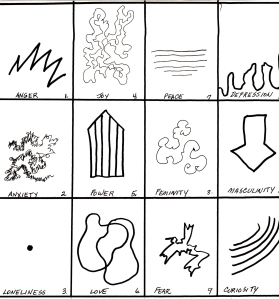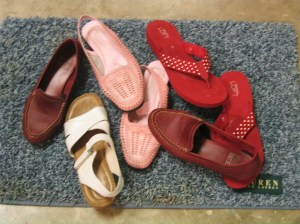Blog Archives
DRAWING: A VISUAL LANGUAGE
I’m sure everyone remembers the old Chinese proverb, “One picture is worth more than a thousand words.” A thousand words seem like a lot, but it does seem true that drawing is a universal language understood in all countries. This is especially noticeable in expressing certain emotions. I sometimes begin my basic drawing classes with an exercise that prompts students to make spontaneous marks on sketchbook paper as I call out a certain human emotion, such as ‘joy.’ After several of these words are called out, the students compare their drawings. It is always amazing to note how much alike the drawings are for the emotions depicted. I ask the students to use lines only, and not symbols. (Someone is always wanting to draw a heart for the word, “love.”) Sometimes the lines can be joined to make shapes, but this is not necessary.
I ask my students to divide their sketchbook paper into 12 blocks, all about 2 x 3 inches each and number the blocks from 1 to 12. Then I call out an emotion and have them quickly draw a line or lines to express that emotion. The emotions used on the example below are 1. anger, 2. anxiety, 3. loneliness, 4. joy, 5. power, 6. love, 7. peace, 8. femininity, 9. fear, 10. depression, 11. masculinity, and 12. curiosity. When the exercise is completed, the students compare their results with others in the class. Some drawings as compared, such as anger, anxiety, and loneliness are almost identical!
Here are my results:
SCATTERED SHOES
This is another great project to do with a classroom full of students. Scatter several objects, such as shoes on the floor randomly. If you’re brave, let each student remove one shoe and add it to the mix. Arrange easels around the arrangement so that each student must look down to draw the composition. Each chooses a section about 15′ wide to draw. The student must draw everything that lies within the section. Not only is this good for showing aerial perspective and overlapping, it forces the student to draw from another viewpoint other than eye level. If you want, have students add color to their composition with colored pencils, oil pastels, or pastel.
DRAW-AROUND WITH CONTOUR
This is a good suggestion for a group drawing project. If you have more than eight students, you will want to divide them up into smaller groups to lessen the amount of time needed. Needless to say, I don’t have an example of this, but the project has been very successful when I’ve used it.
Arrange a group of students in a circle around a table. Each is given a small, simple object to be described with contour line. Give them three minutes to do the drawing. At the end of that time, have each student get up, leaving their object and drawing in place, and move clockwise to the next student’s object. They then draw that object on the new student’s paper. Tell them to draw the object larger, smaller, or in another position, and overlap the previous drawing when they can. The drawing can even go off the page if they wish. After three minutes, the students get up again and go to the next position, drawing that student’s object on his/her paper. Keep doing this until all the students have returned back to their original position. Now they can shade in four values to integrate background and foreground, and make the drawings look more 3-dimensional. Display the drawings so that all can see the results.

